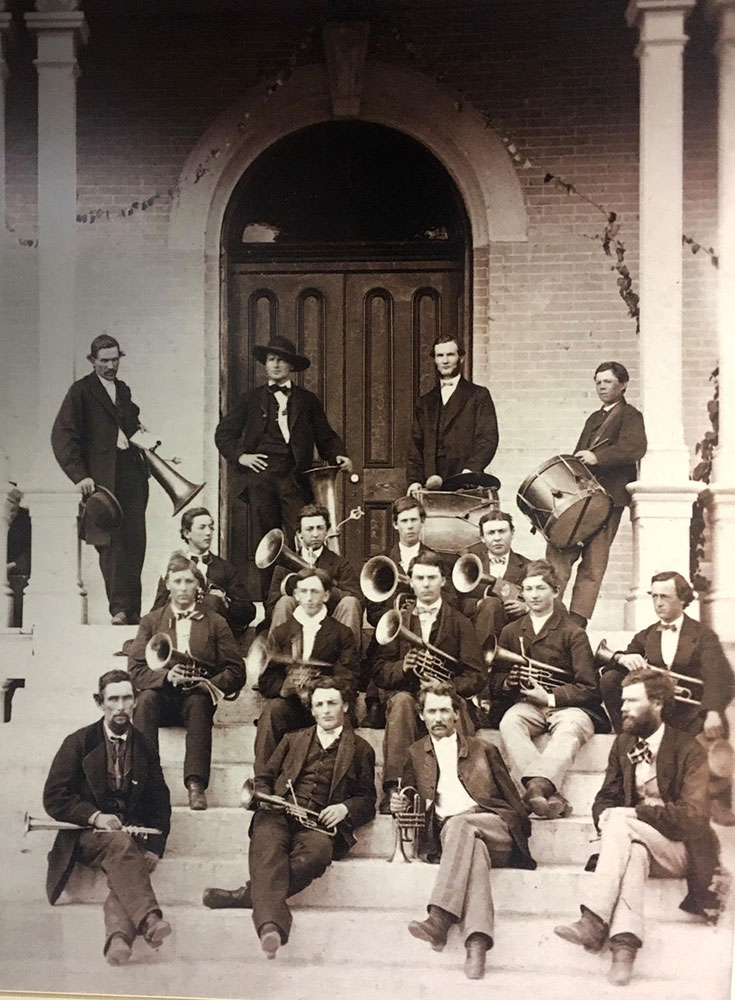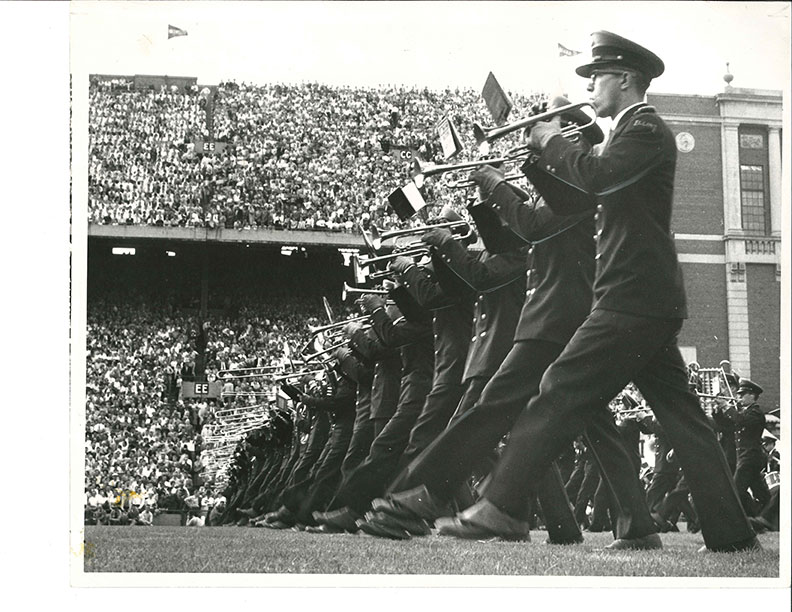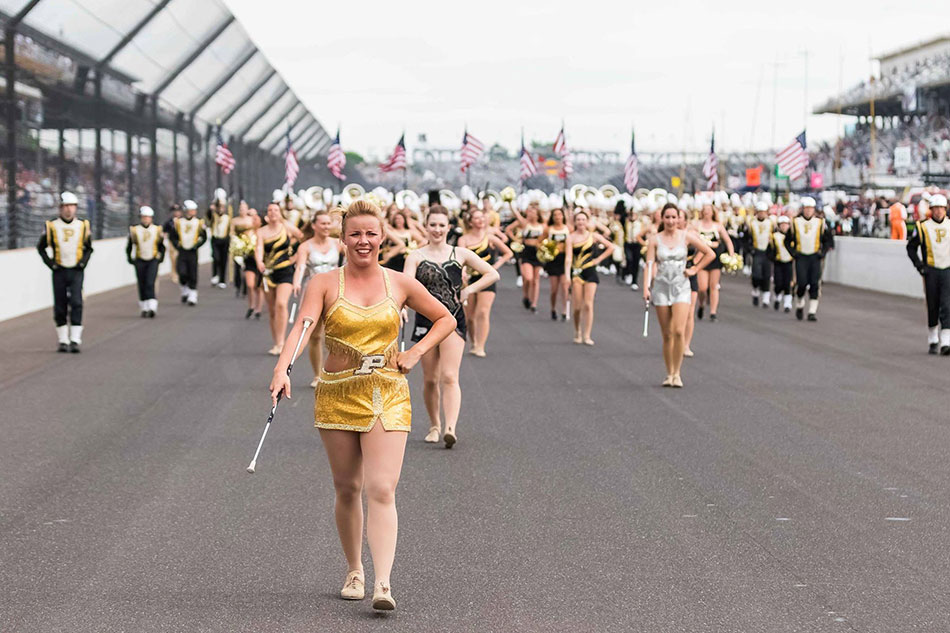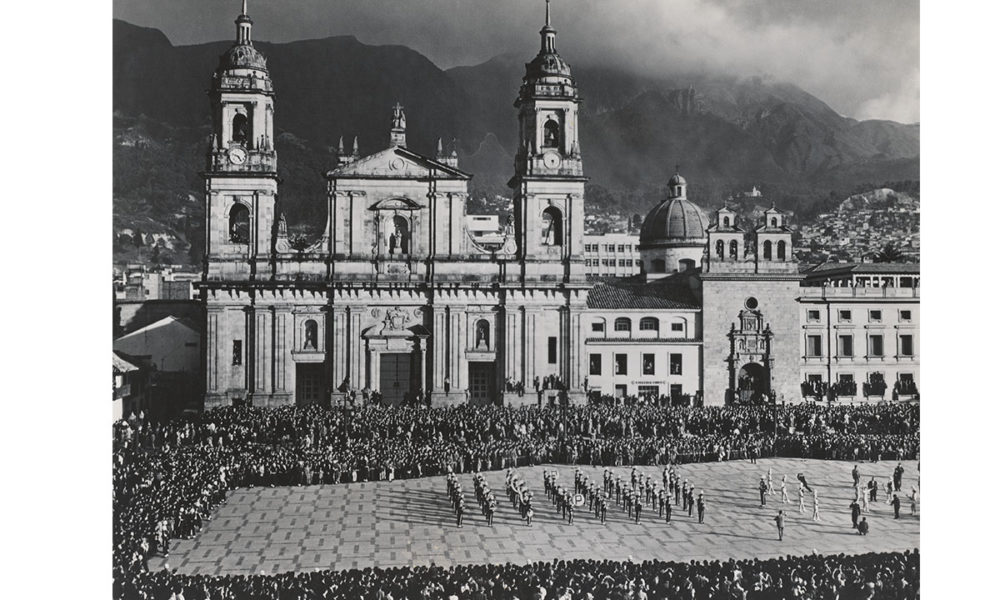Historic university bands continue to innovate while keeping traditions alive.
Oldest College Band

University of Notre Dame (Indiana)
Music is a strong part of the University of Notre Dame’s history. Just a few years after the university was founded in 1842, its band formed.
“The Notre Dame Band began during the 1845-46 academic year, with music lessons in the fall of 1845,” says Larry Dwyer, assistant director of bands for the Band of the Fighting Irish. “Its first performance was at the university’s first commencement ceremony in 1846.”
Victory March
Today, the school’s band is strongly associated with its performances at home football games, but for the first 41 years of its existence, the band only performed in other venues.
“Notre Dame’s first football game was on Nov. 23, 1887,” Dwyer says. “The band played at the event and has played at every home football game ever since. The entire band plays at all home football games, at select away games, and at all the major bowl games in which the football team plays.”
This past Dec. 29, the band traveled to Arlington, Texas, to play at the Cotton Bowl, the school’s 37th bowl appearance.
The band supports the football team with the school’s fight song, “Notre Dame Victory March.” The band performed it for the first time in 1909. The version that’s still performed today is a 1923 arrangement.
“The ‘Victory March’ is played at every Notre Dame band concert and is played frequently during every home football game,” Dwyer says. “Someone once remarked that at a Notre Dame football game, there is some child on campus who is hearing the ‘Notre Dame Victory March’ for the first time and perhaps some older person who is hearing it for the final time.”
School Support
Since the 1940s, the band has toured the country, performing as far away as Maine and Texas. In recent years, it has added international destinations, performing at world-class venues like the Sydney Opera House. The group has played for several presidents, including Dwight D. Eisenhower, John F. Kennedy, Jimmy Carter, Ronald Reagan, George Bush, George W. Bush, and Barack Obama.
During wartime, the band played whenever students left school to enlist in the Armed Forces. “It played at the university’s Main Circle as students left to join the armies—both North and South—during the Civil War,” Dwyer says. “The band played at the circle whenever students left to fight in World War I, World War II, Korea, and Vietnam.”
Initially, the band only had a few dozen members, but by the 1920s, when Knute Rockne was head football coach, it grew to about 100 members. Today, the band boasts more than 400 members.
The university demonstrated its strong support of the band when a new building for the law school was constructed in 2009. “The building’s location would have blocked the path of the marching band’s traditional game-day march to the stadium,” Dwyer says. “University architects decided to put a large arch in the center of the building to enable the band to continue its tradition.”
The band itself received a new practice field with synthetic turf, lighting, and a director tower in 2017.
First Halftime Show by a Marching Band

University of Illinois at Urbana-Champaign
The first football halftime show is said to have been performed by the University of Illinois in a game against the University of Chicago on Oct. 19, 1907.
The Illinois band was originally established in 1868 as a military band. Its first formal performance occurred in 1872 to dedicate a new building on campus. Several years later in 1890, it held its first formal concert.
Travel Opportunities
Over the past century-plus, the Marching Illini’s performances have attracted fans from the university community as well as a much wider audience.
“The band has traveled in various places for bowl games and also to London, England,” says Barry L. Houser, associate director of bands and director of athletic bands.
Houser adds that Illinois was one of the first college marching bands to travel to Dublin, Ireland, to perform in the official St. Patrick’s Festival Parade, “something the band has continued to do every four years or so.”
The band also performed at the Macy’s Thanksgiving Day Parade in New York in 2015.
Cutting-Edge Yet Traditional
The band lays claim to many other firsts, including performing at the first college homecoming game in 1910 and during the first football game that was broadcast on radio in 1924. The band released a CD in 1986 and a website in 1994. Today, the group prides itself on being innovators for going paperless.
“We have [moved] to a total paperless program—drill and music and all logistics,” Houser says. “This has been done by each member using their phone with an eFlip. We helped with the testing of this device before it went into full production.”
At the same time, the 375-member band enjoys steeping itself in well-loved university traditions, including performing the “Three-in-One,” a medley of Illinois songs, at every home football game since 1926.
Its pregame tradition includes playing “God Bless America” while forming the outline of the continental United States on the field with percussion members forming the state of Illinois and one lone cymbals player standing where the city of Champaign would be.
The musicians play at several other campus sporting events, from basketball games to wrestling matches to gymnastics meets. “The Marching Illini is very much a part of the fabric of the university, performing for campus events such as the annual homecoming parade, freshmen convocation, [as well as] all football, basketball, and volleyball home events,” Houser says.
First Band to Use Pictorial Formations

Purdue University in West Lafayette, Indiana
Twenty years after Purdue University’s “All-American” Marching Band began playing during school football games, it created a pictorial formation on the field. In 1907, the marching band broke military ranks and debuted its Block P formation after the student band director, Paul Spotts Emrick, got the idea by watching some birds fly by.
“His inspiration was seeing geese flying overhead in a V formation,” says Jay Gephart, director of bands at Purdue University. “Spotts was a real innovator at the time, which is remarkable for someone who had no music degree.”
Many people in the marching industry believe that Purdue made history as the first marching band to create a pictorial formation on the field, and Purdue commemorates the year in its university archives.
Today, the Block P formation is one of the longstanding traditions that the Purdue “All-American” Marching Band is proud to carry on.
“The many traditions that have been upheld for decades include the formation of the Block P at pregame [and] the use of Big Ten flags representing the school colors of all Big Ten universities,” Gephart says. “We will [soon] celebrate the 100-year anniversary of the ‘World’s Largest Drum,’ which came to Purdue in 1921. At the time, it was the world’s largest freestanding bass drum.”
All-American, World-Renowned
The band, which was established in 1886—a year before Purdue’s football team was formed—has played at many notable locations around the country and world. In the 1960s, Radio City Music Hall in New York hired many of its musicians to perform during summer break.
“These individuals played four shows a day, seven days a week for 10 weeks,” Gephart says. “In fact, several Purdue musicians met their spouses while working in New York City. Their future spouses were members of the Radio City Rockettes!”
Over the years, the band has marched in world-renowned events like the Macy’s Thanksgiving Day Parade in New York and the St. Patrick’s Festival Parade in Dublin, Ireland. In 2008, it performed for an international audience in China.
“We were the first college band invited by the Chinese Ministry of Culture to perform in Beijing for events leading up to the Olympics,” Gephart says.
Under Spotts, the band was one of the first in the country to wear lights on the uniforms, Gephart adds. Today, the band sometimes illuminates its uniforms but with a 21st-century twist. “Technology has enabled us to take this to new heights with the use of LED lights controlled by a computer,” Gephart says. “We have used these lights numerous times for halftime shows, parades, and more.”
Heartbeat of the University
Innovation is important to the band, which has nearly 400 members. It prides itself on creating a new performance for each home game halftime show. And without a separate music school at the university, the band members’ devotion to the program is even more appreciated by the administration, students, and alumni.
“We refer to the All-American Marching Band as the heartbeat of the university,” Gephart says. “Our university community is very proud of our band for our commitment to excellence, innovation, and creativity. Most importantly, the university is proud of the manner in which we represent our university, our community, and the state of Indiana.”
First College Fight Song

Boston College
This year, the Boston College band will celebrate its centennial year. When it formed in 1919, the school’s fight song, “For Boston,” had already existed. During the 1919 concert that marked the band’s debut performance, the Boston College Glee Club sang the fight song. It’s unknown exactly when the marching band began performing the song during football games.
Believed to be the country’s oldest college fight song, “For Boston” was penned by T.J. Hurley, who graduated from Boston College in 1885.
“T.J. Hurley was an active musician on campus,” says Dr. David Healey, director of the marching band at Boston College. “The original version appears to have been written for piano and voice rather than band. Unfortunately, I can’t confirm whether T.J. Hurley composed ‘For Boston’ as a student or as a young alumnus.”
Shorties but Goodies
The Boston College Marching Band performs “For Boston” among its medley of fight songs during pregame. For halftime shows, the band has played a mix of music, ranging from classical compositions from Beethoven and Aaron Copland to contemporary hits from Queen and Childish Gambino. But the band—which has been called the “Screaming Eagles” since the 1980s—is best known for its performances in the stands during home football games.
“The typical college football game lasts approximately three-and-a-half hours whereas a typical halftime show lasts only five to 10 minutes,” Healey says. “One of the critical questions we asked ourselves in 2000 is: ‘What are we doing with the remaining three hours and 20 minutes?’ In response, we arranged 40 brief musical selections, affectionately referred to as ‘shorties,’ to coincide with thematic elements throughout the game.”
The band’s musical cues let fans know when key moments in the game arise, so the crowd can support the football team. “They generate enthusiasm and participation with familiar refrains that are unmistakable and engage fans of all ages and levels of interest,” Healey says. “They are powerful, compelling, unrelenting, and effective. These selections may not be the primary reason for our impressive home record, but they undoubtedly play a role in galvanizing our fans and providing a much-needed lift to the team.”
For Sports Fans and Beyond
Nearly 200 students perform in the marching band. Over the years, it has performed in notable events like the Macy’s Thanksgiving Day Parade in New York, the Japan Bowl in Yokohama, Japan, and President Obama’s second Inaugural Parade in Washington, D.C.
Sports reign supreme in Boston, and the marching band helps to generate excitement for collegiate games on a level that’s appealing to people outside of the college community.
“In a city where sports fans can choose from among multiple professional options, including the Red Sox, Celtics, [New England] Patriots, and Bruins, we offer the same fans a compelling reason to come to a college event—live performances of the students, by the students, and for the students,” Healey says. “From a philosophical perspective, the sound of the Boston College Marching Band is the sound of Boston College.”


